If you’re interested in technical analysis, you may have heard about candlestick chart patterns. These patterns are commonly used by traders to identify potential buy and sell opportunities in the stock market. In this article, we’ll explain all 34 candlestick chart patterns and how to recognize them.
What are Candlestick Chart Patterns?
Candlestick chart patterns are visual representations of price movements in the stock market. They display the opening, closing, high, and low prices of a security in a specific time frame. Each candlestick has a body and two wicks or shadows that indicate the highest and lowest prices during that period.
Traders use candlestick chart patterns to identify potential buying or selling opportunities. By analyzing the pattern of a particular security, traders can make informed decisions about when to enter and exit trades.
Candlestick patterns provide valuable insights into market trends and can be used to support trading strategies. Because they are easy to read and interpret, many experienced traders rely on them to make important trading decisions. Using candlestick patterns can help traders identify support and resistance levels, possible reversals, and overall market sentiment for any given security.
They are especially useful in volatile markets where traditional indicators may not provide enough information. With a proper understanding of candlestick chart patterns and their interpretation, traders can gain an edge in trading. Here you can read more about the best patterns we use in our trades.
How to Read Candlestick Charts?
Candlestick charts are a popular tool used by traders to analyze and interpret market trends. They provide a visual representation of price movements and can help traders make informed decisions about buying and selling stocks or other financial assets.
To read a candlestick chart, you need to understand the different components of the candlestick. Each candlestick represents a specific time period, such as one day or one hour, and is made up of four parts: the opening price, the closing price, the highest price, and the lowest price.
The body of the candlestick represents the opening and closing price of the asset. If the opening price is lower than the closing price, the candlestick is usually colored green or white, and it’s said to be a bullish candlestick, indicating a price increase.
If the opening price is higher than the closing price, the candlestick is usually colored red or black, and it’s said to be a bearish candlestick, indicating a price decrease.
The highest and lowest prices of the asset during the time period are represented by the upper and lower shadows or wicks of the candlestick. The length of the wicks can indicate how much the price has fluctuated during the time period.
To use candlestick charts effectively, it’s important to learn to recognize the different candlestick patterns, such as doji, hammer, and spinning top. These patterns can provide valuable information about potential market trends and can be used in combination with other technical analysis tools to make informed trading decisions.
Single Candlestick Patterns
Single candlestick patterns are one of the most important concepts to understand when it comes to trading in the stock market. A single candlestick pattern is a charting pattern that consists of only one candle. Generally, these patterns can be used to predict the future direction and strength of price movements.
There are four primary types of single candlestick patterns, each of which can provide insight into the market’s direction and momentum:
- The Bullish Engulfing Pattern – This pattern occurs when a red candle is followed by a much larger green candle, indicating that buyers are in control. Bullish Engulfing Pattern: Definition, Example, and What It Means (investopedia.com)
- The Bearish Engulfing Pattern – The opposite of the Bullish Engulfing Pattern, this pattern occurs when a green candle is followed by a much larger red candle, indicating that sellers are in control. Bearish Engulfing Pattern: Here’s what you need to know. – Streak Tech
- The Hammer Pattern – This pattern occurs when an extremely long lower shadow is followed by a small real body with little or no upper shadow. It is indicative of buying pressure and suggests that the price may go up in the near future. The Hammer Candlestick Pattern: Identifying Price Reversals | Libertex.com
- The Shooting Star Pattern – This pattern occurs when an extremely long upper shadow is followed by a small real body with little or no lower shadow. It is indicative of selling pressure and suggests that the price may go down in the near future. Guide To Understanding Shooting Star Candlestick Patterns – Commodity.com
These patterns are just a few of the many patterns seen in technical analysis. While they can be helpful in determining potential price movements, it is important to remember that these patterns should not be taken as guarantees. A trader must always keep an eye on current market conditions and adjust their strategy accordingly.
1. Doji
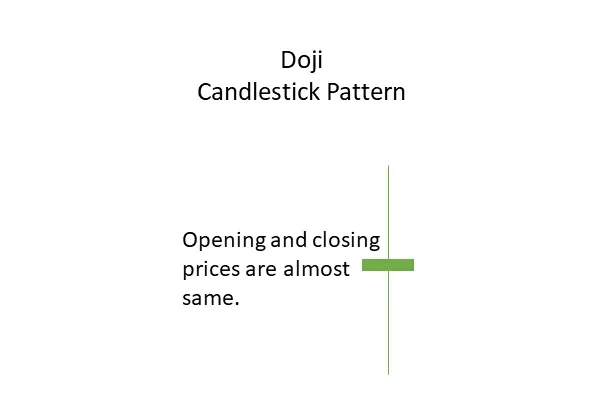
A Doji is a candlestick pattern that occurs when the opening and closing prices of a security are the same or very close. It indicates indecision in the market and can signal a potential trend reversal.
The Doji is often seen as a sign that the bulls and bears are in equilibrium, so the strength of either side of the market is uncertain. Dojis can also be used to confirm existing trends by appearing after an extended move or as part of a longer-term trend. In addition, a Doji can signal a possible end to a trend or the beginning of a new one.
As with any chart pattern, it is important to look for confirmation from other indicators such as volume, momentum, and trendlines before making any decisions. With proper analysis, Dojis can be a great tool for traders of all levels! What Is a Doji Candle Pattern, and What Does It Tell You? (investopedia.com)
2. Hammer
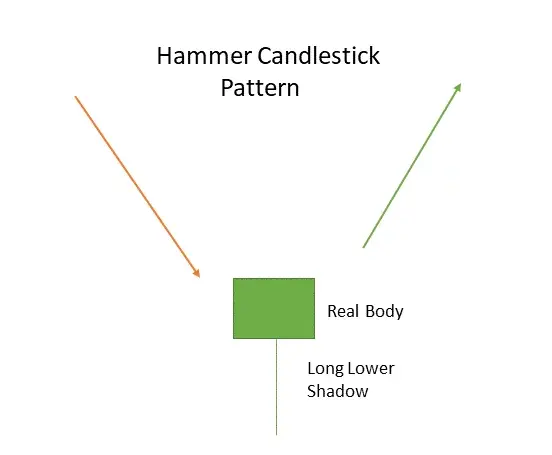
A hammer is a candlestick pattern that has a small body and a long lower wick. It indicates that buyers have stepped in and pushed the price up after a downtrend.
The hammer is considered to be a bullish reversal pattern. When it appears, it shows that the bears have lost control of the price and buyers are pushing the market back up. This can also signal a potential bottom in the market or a possible trend reversal. Traders should watch for confirmation before taking any action. The confirmation may come from other indicators such as volume or moving averages. If the pattern is confirmed, traders can enter into a long position as the market moves higher.
The hammer is usually made up of one candle and requires confirmation from other indicators to take action. It is important to remember that no single indicator should be relied upon exclusively when trading. Traders should use multiple sources of analysis to make informed decisions.
If the hammer is confirmed, traders should pay attention to the size and shape of the candle. A larger candle with a wide lower wick may indicate strong buying pressure at that level, setting up a possible bottom in the market.
3. Hanging Man
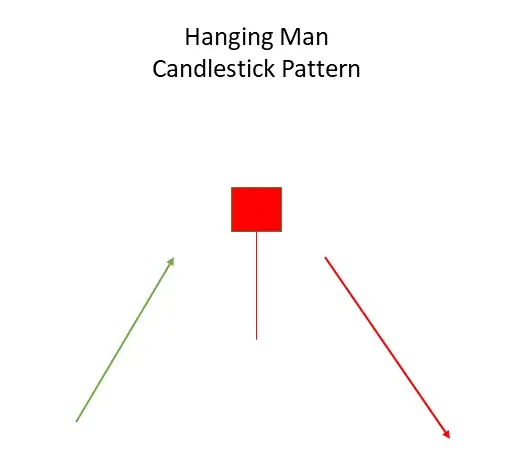
A hanging man is the opposite of a hammer. It has a small body and a long lower wick, but it appears after an uptrend. It can signal a potential reversal to a downtrend. Investors should be aware of the risks that come with investing in a stock or asset when a hanging man appears.
Hanging man patterns are often used by technical analysts to identify potential trend reversals and can help investors decide whether they should enter or exit a particular trade. The key takeaway is to remain vigilant when it comes to the markets, as no one can predict the direction of a stock or asset with 100% certainty. Knowing what signs to look for, such as a hanging man pattern, can help investors make more informed decisions.
4. Shooting Star
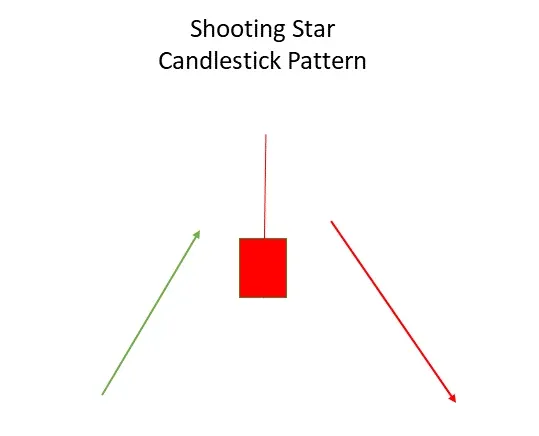
A shooting star has a small body and a long upper wick. It appears after an uptrend and can signal a potential reversal to a downtrend. This candlestick formation is created when the open and close prices of a security are near each other, but the high price exceeds that of the previous period.
Shooting stars indicate that traders are willing to pay higher prices for security at the start of a period, only to be met with strong selling pressure. Consequently, this bearish signal can imply that the uptrend is no longer supported and a downtrend may be beginning.
Investors should watch for confirmation of this bearish trend before entering a position, as sometimes shooting stars are nothing more than temporary pauses in an otherwise strong uptrend. If a shooting star occurs near resistance, it could also be signaling a potential reversal.
Investors should also take into account other technical indicators and fundamentals to gain a better understanding of the market environment before making trading decisions.
5. Inverted Hammer
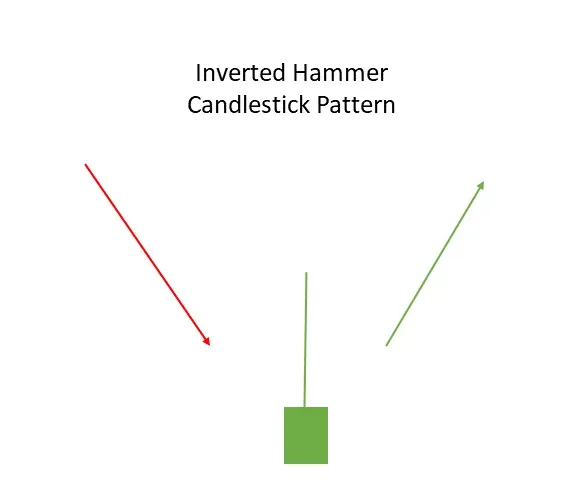
An inverted hammer is similar to a hammer, but it appears after a downtrend. It has a small body and a long upper wick, indicating that buyers have stepped in and pushed the price up. However, by the end of the day, sellers were able to push the price back down. The inverted hammer can be viewed as a sign that buyers are becoming interested in the stock and could start a new uptrend soon.
6. Gravestone Doji
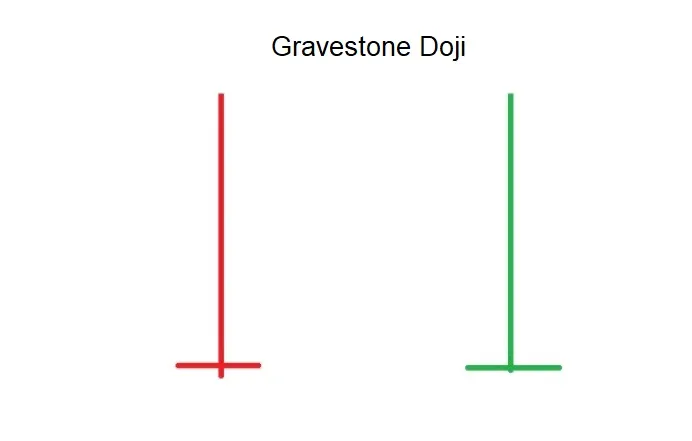
A gravestone doji has a long upper wick and no lower wick, indicating that the price opened and closed at the same level. It appears after an uptrend and can signal a potential reversal to a downtrend.
However, it can also indicate a period of indecision between buyers and sellers. Traders should watch for further confirmation of the trend before entering a position.
A gravestone doji can be used in combination with other technical analysis indicators such as support and resistance levels and moving averages to help determine potential trading opportunities.
Dual Candlestick Patterns
Dual Candlestick patterns are a type of chart pattern used by technical traders to identify potential trading opportunities. They consist of two candlesticks, with one representing the opening and closing prices for a given period, and the other representing the maximum price and minimum price for that same period. The shape of the candles gives an indication as to whether the price of an asset is likely to move up or down in the near future.
Through careful analysis, traders can use this information to decide whether they should enter or exit a trade. Dual candlestick patterns can be used with any type of trading strategy and in any time frame. It is important for traders to practice proper risk management when using dual candlestick patterns, as any trade carries with it a certain amount of risk.
With that in mind, traders should strive to use dual candlestick patterns as part of an overall trading strategy that is designed to minimize risk while maximizing potential rewards.
7. Bullish Engulfing
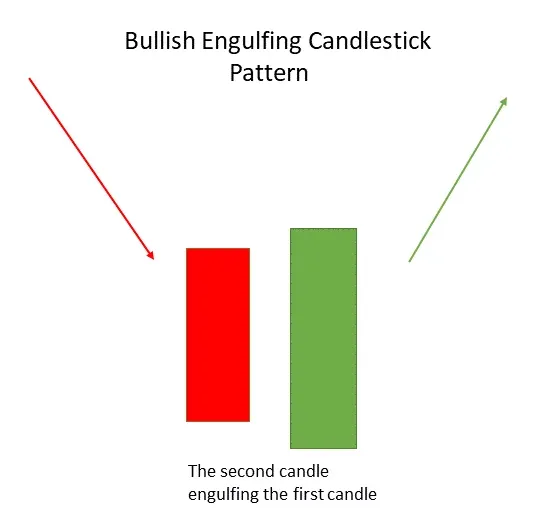
A bullish engulfing pattern occurs when a small bearish candlestick is followed by a larger bullish candlestick that completely engulfs the previous one. It can signal a potential trend reversal to an uptrend.
The pattern is considered a bullish signal if it appears in a downtrend and can be seen as an indication that buyers have taken control of the market and are pushing the price higher.
Traders should watch for this pattern to confirm a reversal before entering trades. A stop-loss order should also be placed just below the low of the engulfing candle in order to protect against any losses. If traders want to confirm the reversal, they can look for further bullish activity such as higher highs and higher lows in the coming days.
This type of pattern is an important one for traders to be aware of and watch for in the markets. It can often indicate a strong move higher in the security being traded.
8. Bearish Engulfing
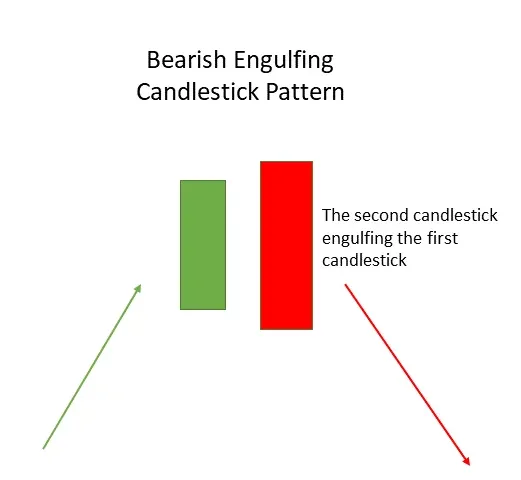
A bearish engulfing pattern is the opposite of a bullish engulfing pattern. It occurs when a small bullish candlestick is followed by a larger bearish candlestick that completely engulfs the previous one. It can signal a potential trend reversal to a downtrend.
This pattern can be a sign of weakness in the current uptrend and indicates that selling pressure is increasing. In order to confirm a bearish engulfing pattern, traders should wait for the price to close below the lower border of the second candlestick. It’s important to wait until it has been confirmed before taking any action on this signal.
9. Piercing Line

A piercing line occurs when a bearish candlestick is followed by a bullish candlestick that opens below the previous day’s low and closes above the previous day’s midpoint. It can signal a potential trend reversal to an uptrend.
This type of pattern is generally seen as a bullish sign, indicating buying pressure and potentially the start of an uptrend. The piercing line occurs most often at the bottom of a downtrend and can signal that buyers have taken control of the market and are pushing prices back up. It is important to understand that this may only be a short-term trend rather than a major reversal.
After the piercing line, traders should watch for higher highs to confirm that a new uptrend is developing. A stop-loss order can be set at the previous day’s low to protect against any losses if the pattern does not work out as expected. Long positions with tight stops can be taken after verifying that the pattern has occurred and that there is increased buying pressure in the market.
10. Dark Cloud Cover
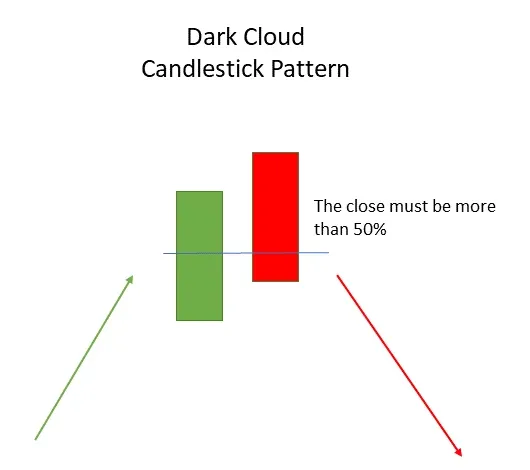
A dark cloud cover is the opposite of a piercing line. It occurs when a bullish candlestick is followed by a bearish candlestick that opens above the previous day’s high and closes below the previous day’s midpoint.
It can signal a potential trend reversal to a downtrend. In this case, investors should be on the lookout for a change in market sentiment and act accordingly. The dark cloud cover is considered to be more reliable when it occurs after an extended uptrend or at a resistance level, as these are signs of increased selling pressure.
Traders can also combine the dark cloud cover with other indicators such as levels of support and resistance, oscillators, or moving averages to confirm a potential trend reversal. It is important to note that dark cloud cover patterns alone are not sufficient for making trading decisions; instead, they should be used in conjunction with other market analysis tools.
11. Bullish Harami
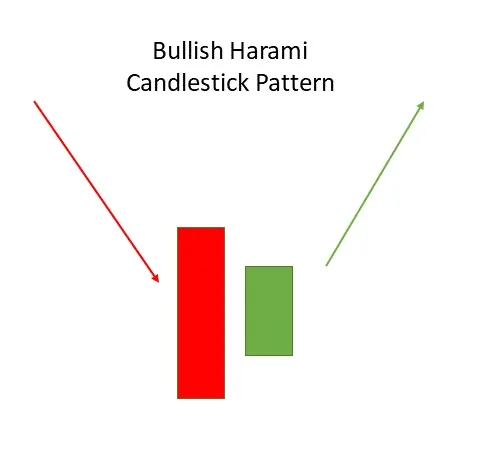
A bullish harami occurs when a large bearish candlestick is followed by a small bullish candlestick that is completely contained within the previous day’s body. It can signal a potential trend reversal to an uptrend. It is important to note that a bullish harami does not always guarantee a trend reversal, and should be considered in the context of other market indicators.
Traders should also be aware of false breakouts, which can occur when the price breaks out of the range established by the first and second candle, only to return back within it again.
12. Bearish Harami
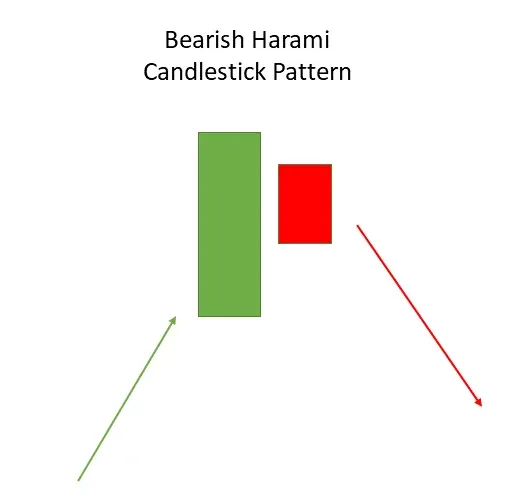
A bearish harami is the opposite of a bullish harami. It occurs when a large bullish candlestick is followed by a small bearish candlestick that is completely contained within the previous day’s body. It can signal a potential trend reversal to a downtrend. Traders should pay close attention to the potential bearish harami and act accordingly. It is important to note that bearish haramis can fail and it is not always an indication of a trend reversal. Therefore, traders should use caution when trading in this pattern.
Additionally, other indicators such as volume, moving averages, and oscillators should be used to confirm the reversal. By combining these factors, traders can better assess their trading strategy and increase the probability of success. A bearish harami is generally considered a reliable indication that a security’s price could be headed lower.
13. Tweezer Bottoms
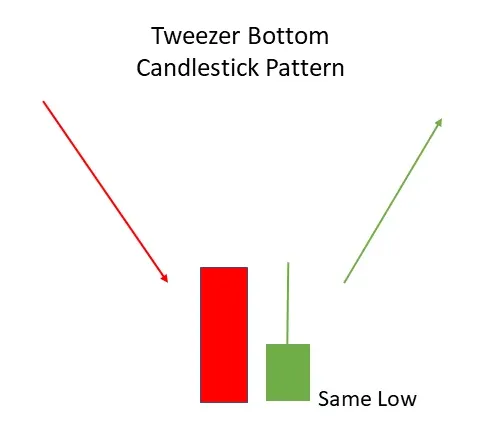
Tweezer bottoms occur when two or more candlesticks have the same low price, indicating that buyers have entered the market at that level. It can signal a potential trend reversal to an uptrend. A tweezer bottom can be used to identify potential entry points for long trades. Traders should look for confirmation in other technical indicators before entering a trade.
Additionally, traders should place stop losses at the lowest price of the tweezer bottom candlesticks in case the trade does not go their way. While tweezer bottoms are a potential sign of a trend reversal, it is important to note that they are not always reliable and should be used in conjunction with other technical indicators.
As with any trading strategy, traders should employ risk management techniques to protect their capital. Moreover, traders may use the tweezer bottom pattern for both short and long positions.
For example, if the market is in a downtrend, trading the tweezer bottom pattern in a short position could be used as a way to capitalize on the prevailing trend. In summary, traders should use this pattern with caution and always employ risk management techniques when entering any trade. By doing so, they can maximize their profits while minimizing losses.
14. Tweezer Tops
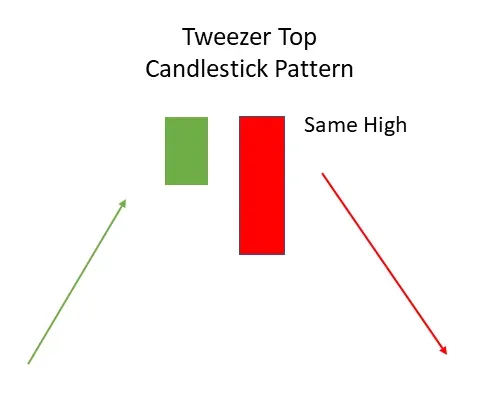
Tweezer tops are the opposite of tweezer bottoms. They occur when two or more candlesticks have the same high price, indicating that sellers have entered the market at that level. It can signal a potential trend reversal to a downtrend. Traders should watch for a bearish candlestick to form after the tweezer top to confirm a potential trend reversal.
Once the bearish candle is identified, traders should enter short positions at market open and place stop losses slightly above the tweezer top. It is also important to monitor volume as increased volume tends to indicate a stronger trend reversal.
The tweezer top pattern is also used as an indication of potential resistance levels. If the market reverses at the same level multiple times, it can be seen as a strong resistance area that could act as a ceiling for further price increases. In this case, traders should watch for bearish candlesticks and be prepared to enter short positions if the resistance is not broken.
It is important to remember that tweezer tops are not an exact science and should be used in combination with other technical indicators for more reliable trading opportunities.
Triple Candlestick Patterns
Triple candlestick patterns are a type of technical analysis used to identify emerging trends or reversal signals in the price of a security. A triple candlestick pattern is identified when three consecutive candles form with their highs and lows either increasing or decreasing. Depending on the type of pattern, this can be an indication that the underlying trend may be reversing or continuing.
This type of analysis is based on the premise that prices move in predictable patterns and can be used to anticipate price movements. As with all technical analysis, it is important to use other indicators for confirmation before acting. Triple candlestick patterns can be a useful tool for traders looking to capitalize on emerging trends or signals in the market.
15. Morning Star
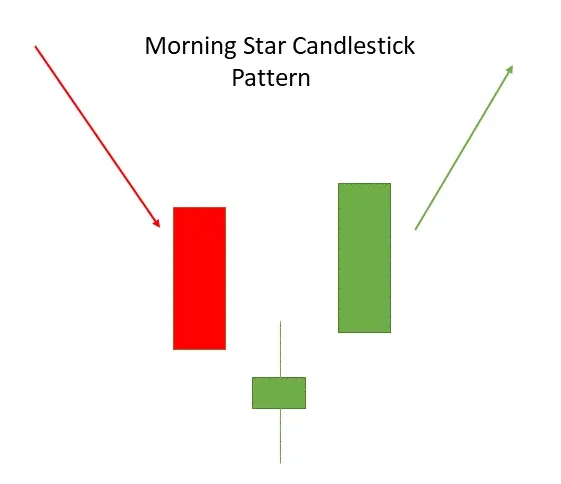
A morning star is a bullish pattern that occurs when a long bearish candlestick is followed by a small-bodied candlestick that gaps down, followed by a long bullish candlestick that gaps up. It can signal a potential trend reversal to an uptrend. The long bearish candlestick reflects the bears’ investment, while the small-bodied candlestick is seen as a pause in the selling behavior.
Finally, the long bullish candlestick indicates that buying pressure has increased and that the bulls have taken control of the market. Traders should confirm any potential reversal by monitoring volume and related technical indicators. If the morning star is seen in an uptrend, it could signal a reversal to a downtrend. Conversely, if seen in a downtrend, it can be interpreted as a potential trend reversal to an upward direction.
16. Evening Star
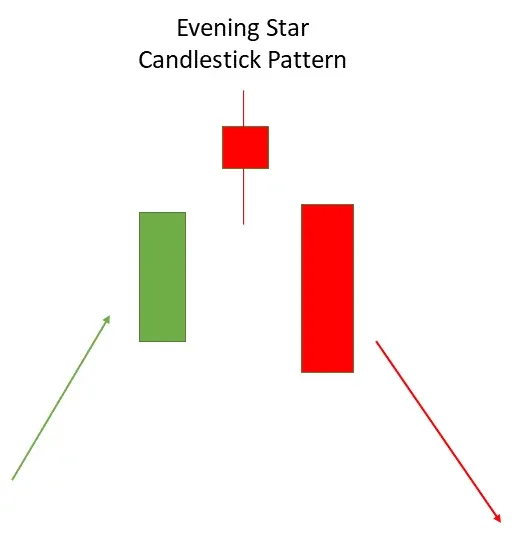
An evening star is the opposite of a morning star. It is a bearish pattern that occurs when a long bullish candlestick is followed by a small-bodied candlestick that gaps up, followed by a long bearish candlestick that gaps down. It can signal a potential trend reversal to a downtrend. Traders should be aware that the Evening Star pattern is only significant when it appears at market tops and not at market bottoms. Traders should watch for price confirmation as further evidence of a possible change in trend.
If the prices move lower after an Evening Star, it could indicate that a bearish trend is forming. Similarly, if the prices continue to move higher after an Evening Star, it could indicate that a bullish trend is continuing. Traders should use caution when trading the Evening Star pattern as false signals can occur if the prices do not confirm the reversal. In addition, traders should remember that no single indicator or signal will accurately predict future price movements.
17. Three White Soldiers
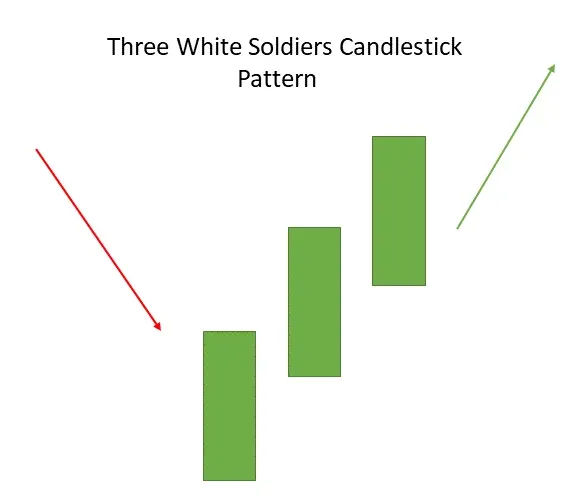
Three white soldiers are a bullish pattern that occurs when three consecutive bullish candlesticks have increasing opening and closing prices. It indicates a strong uptrend. This pattern is often used by traders to signal that a market has reversed its downward trend and could be headed upwards.
In order for the three white soldiers’ pattern to form, all three candles must open within the body of the previous candle, creating an increasingly strong move up. The close of each candle should be higher than the opening of the previous one.
18. Three Black Crows
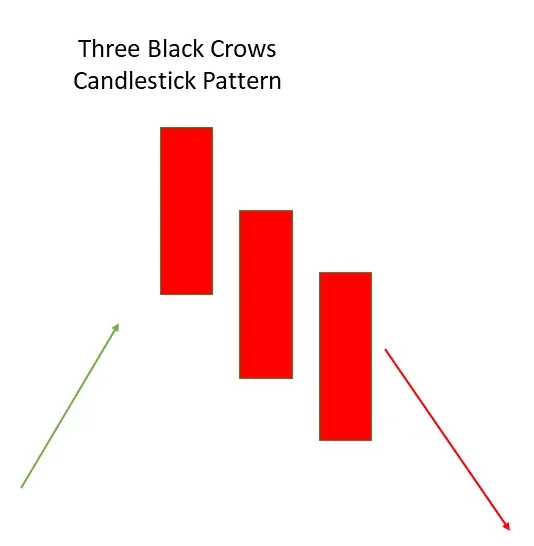
Three black crows are the opposite of three white soldiers. They are a bearish pattern that occurs when three consecutive bearish candlesticks have to decrease opening and closing prices. It indicates a strong downtrend. It also suggests that market participants are expecting the price to continue its current trend.
The three black crows pattern is particularly potent when it follows a significant uptrend or a long period of consolidation. As with all technical analysis tools, traders should use other indicators in conjunction with this pattern to confirm any bearish signals.
19. Bullish Three Inside Up
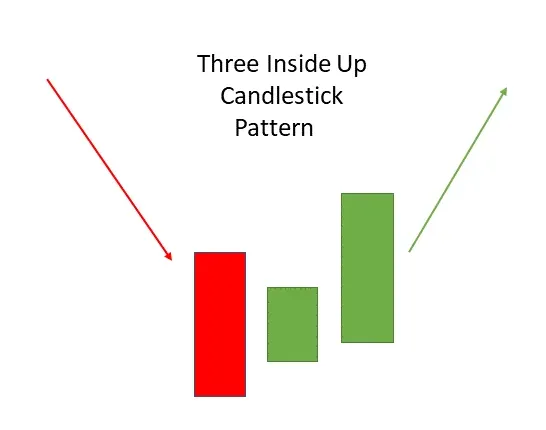
A bullish three-inside-up occurs when a long bearish candlestick is followed by a small bullish candlestick that is completely contained within the previous day’s body, followed by a long bullish candlestick that closes above the previous day’s high. It can signal a potential trend reversal to an uptrend.
This pattern should be used in conjunction with other technical indicators to confirm the direction of the trend. Traders should also consider the fundamental analysis and risk management principles when trading this pattern. By paying attention to these details, traders can implement a well-rounded approach when using bullish three-inside-up patterns as part of their strategy.
The first step to trading the bullish three-inside-up pattern is to identify it on a chart. This pattern will generally appear after an extended period of bearishness and can signal that bulls may be entering the market.
The second step is to look for confirmation from other technical indicators such as a moving average crossover, or a break above resistance levels. Finally, traders can look to place a buy order at the break of the pattern’s highest high, with a stop loss placed below the lowest low. If executed correctly, this strategy can yield profitable gains in markets exhibiting strong bullish momentum.
Ultimately, using technical patterns such as the bullish three-inside-up is part of a savvy trading strategy, as it allows traders to take advantage of a trend in the right direction. However, it’s important to remember that such strategies need to be used with caution, and effective risk management should always be employed.
20. Bearish Three Inside Down
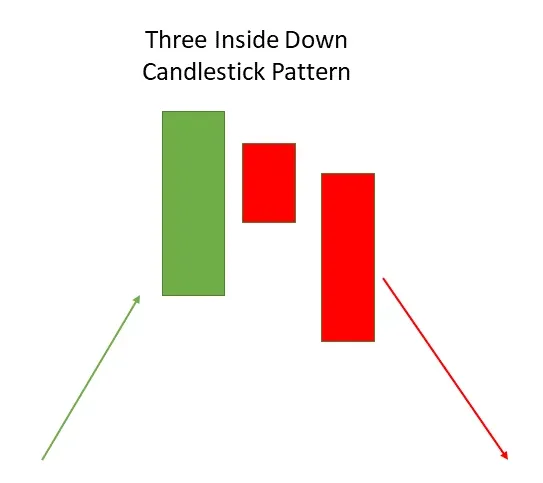
A bearish three inside down is the opposite of a bullish three inside up. It occurs when a long bullish candlestick is followed by a small bearish candlestick that is completely contained within the previous day’s body, followed by a long bearish candlestick that closes below the previous day’s low. It can signal a potential trend reversal to a downtrend.
Traders often watch for this pattern to help inform their trading decisions. When encountered, traders should be aware of the bearish implications and consider entering short positions. It is important to note that the three inside down does not guarantee a price move lower; it only suggests a potential reversal has occurred and increases the possibility of further downward momentum.
Continuation Patterns
Continuation patterns are technical analysis tools used to identify the future direction of a given market. They are based on observing price action over a period of time and using this data to anticipate whether the trend will continue or reverse.
Continuation patterns can be used to determine entry points for buying or selling. They also provide an indication of the strength of the current trend, giving traders an idea of how long it is likely to last. By analyzing continuation patterns, traders can anticipate market movements and make better trading decisions.
21. Rising Three Methods
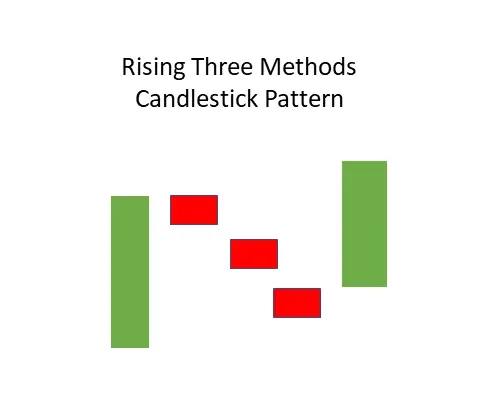
The rising three methods are a bullish continuation pattern that occurs when a long bullish candlestick is followed by three small-bodied bearish candlesticks that are all contained within the range of the first candlestick, followed by another long bullish candlestick. It indicates a continuation of an uptrend.
The three methods can also be referred to as a Three Methods Reversal pattern and is a strong reversal signal. Traders should enter long positions after the third candlestick closes above the high of the first candlestick in this pattern. It’s important to note that confirmation may be required before taking any action when trading this pattern.
22. Falling Three Methods
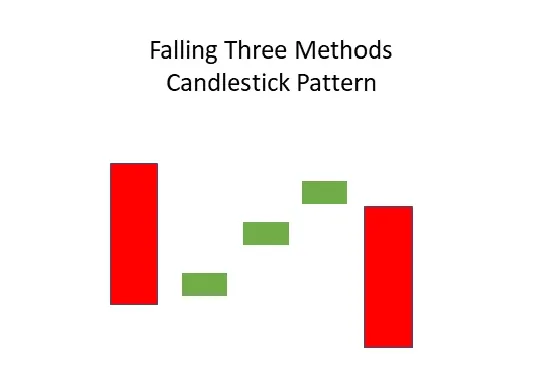
The falling three methods are the opposite of the rising three methods. They are a bearish continuation pattern that occurs when a long bearish candlestick is followed by three small-bodied bullish candlesticks that are all contained within the range of the first candlestick, followed by another long bearish candlestick.
It indicates a continuation of a downtrend. Traders should look for bearish signals to take a short position when the price breaks out of the third candlestick’s range and falls below its low.
A stop-loss can be placed above the high of the third candle in case of an upside reversal. The falling three methods pattern is considered to be one of the more reliable continuation patterns. It is important to note that the pattern can fail in a strong uptrend, so caution must be taken when trading this pattern.
23. Bullish Flag Pattern
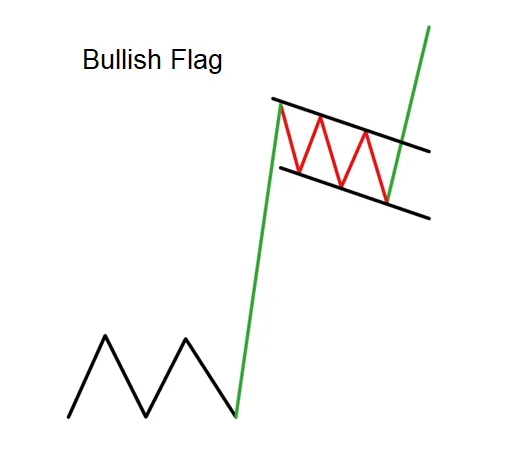
A bullish flag is a continuation pattern that occurs when a sharp uptrend is followed by a short-term consolidation period, forming a flag shape. It can signal a potential continuation of the uptrend. This pattern is formed when a stock experiences a sharp uptrend, pauses for a few days or weeks, and then resumes the upward momentum. The ‘flag’ part of the pattern should form between two parallel trendlines, with the lower line at an angle steeper than 45 degrees.
Once the upper trendline is broken, it can signal the resumption of the uptrend. Traders should look for volume confirmation to ensure the breakout is a valid one. The end result should be a continuation of an established trend. When trading with a bullish flag pattern, traders should set their stop-loss orders just below the lower trendline.
This will help to protect against any unexpected price movements that may take the stock lower. After setting a stop-loss order, traders should consider taking profits when the price reaches the upper trendline of the flag or at some point beyond it. This will help to maximize gains in a successful trade. With any trading pattern, it’s important to remember that past performance does not guarantee future results.
24. Bearish Flag
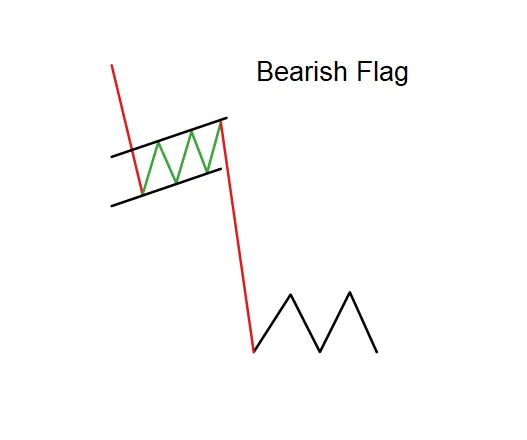
A bearish flag is the opposite of a bullish flag. It occurs when a sharp downtrend is followed by a short-term consolidation period, forming a flag shape. It can signal a potential continuation of the downtrend. Traders may enter a short position after the bearish flag has formed, in anticipation of further downward movement.
As with all chart patterns, it is important to wait for confirmation before entering any trades. Volume and momentum should also be monitored closely to confirm the reversal or continuation of the trend.
25. Bullish Pennant
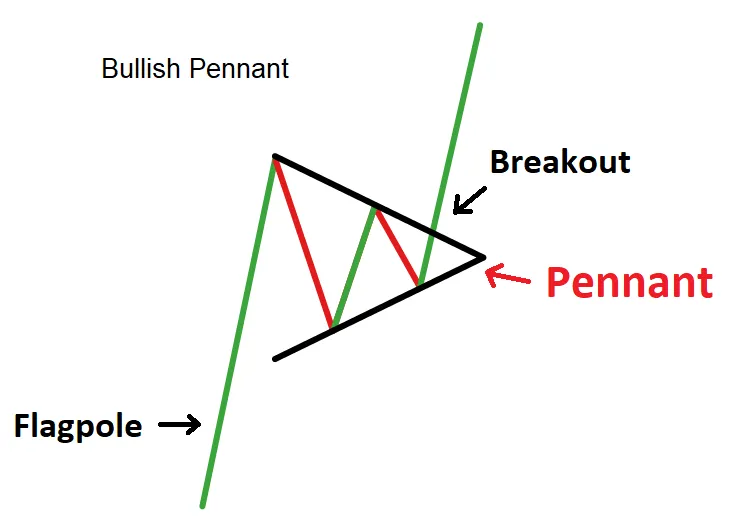
A bullish pennant is similar to a bullish flag, but it has a triangular shape instead of a rectangular shape. It occurs when there is a sharp uptrend followed by a short-term consolidation period that forms a symmetrical triangle. It can signal a potential continuation of the uptrend. Traders should watch for a break above the upper trend line of the triangle to enter a long position. Once this happens, traders should place their stop loss at the lower trendline of the pennant.
A target price can be determined by subtracting the height of the triangle from the breakout point. The target price is generally reached in about three weeks after the breakout. This could be a great way to profit from an uptrend in the stock market.
26. Bearish Pennant
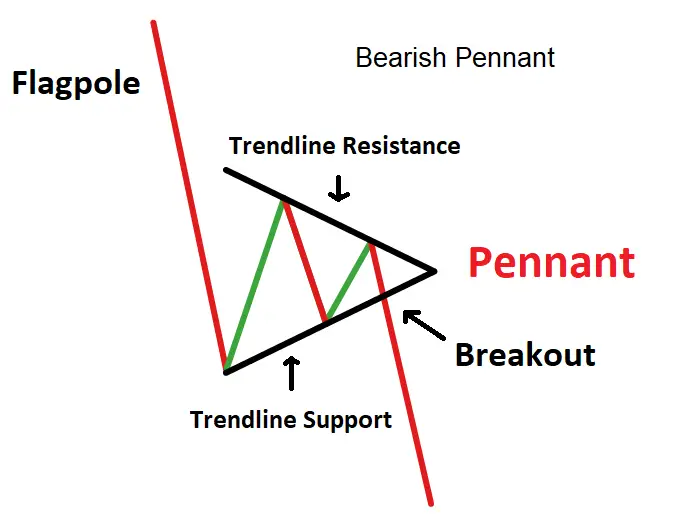
A bearish pennant is the opposite of a bullish pennant. It occurs when there is a sharp downtrend followed by a short-term consolidation period that forms a symmetrical triangle. It can signal a potential continuation of the downtrend.
The bearish pennant pattern is formed during a downtrend, and it is a signal of an impending fall in prices. After the initial sharp move downward, the bears take control and push prices lower until they reach a point at which buying pressure counteracts the selling pressure. This triggers a brief pause in price action that creates the pennant shape.
27. Bullish Rectangle
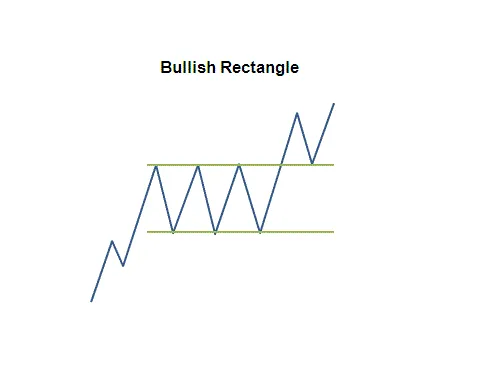
A bullish rectangle is a continuation pattern that occurs when there is a consolidation period between two parallel trendlines. The trendlines should be horizontal. It can signal a potential continuation of the uptrend. The rectangle should have at least two highs and two lows, with the market trading between the trendlines.
The bullish rectangle can often be seen as a period of indecision in the marketplace, with buyers and sellers being relatively equal in their actions. A breakout from this pattern is usually a sign that traders are becoming more aggressive but usually only in the direction of the prior trend. When this occurs, you should look for a continuation of the uptrend and enter a long position.
28. Bearish Rectangle
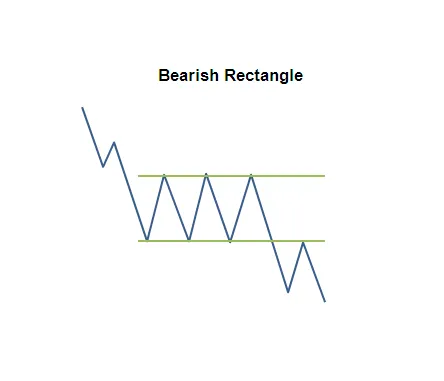
A bearish rectangle is the opposite of a bullish rectangle. It occurs when there is a consolidation period between two parallel trendlines, with the trendlines being horizontal. It can signal a potential continuation of the downtrend. A break below the lower trend line would confirm a bearish rectangle and could lead to further losses. It is important for traders to be aware of this pattern, as it can help them identify entry and exit points in their positions.
Additionally, traders should watch for signs of reversal before entering long positions; a bullish breakout from the rectangle pattern can signal that the downtrend has reversed and that a new uptrend is beginning. By closely monitoring rectangle patterns, traders can better prepare for both entry points and potential reversals.
29. Bullish Wedge
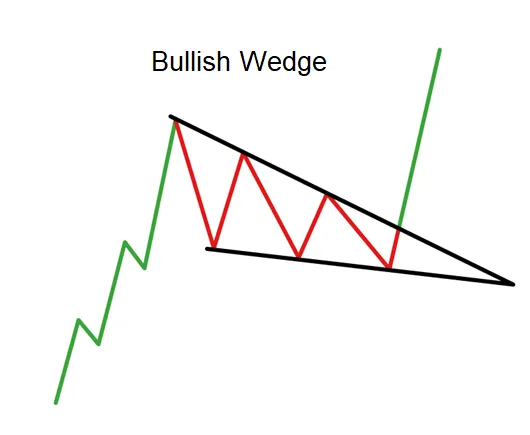
A bullish wedge is a continuation pattern that occurs when there is a consolidation period between two converging trendlines that slant upward. It can signal a potential continuation of the uptrend.
The pattern is typically seen as a sign of strength for the underlying asset. A break above the upper trendline signals a continuation of the prevailing uptrend, while a fall below the lower trendline suggests a potential reversal and bearish sentiment. Generally, the volume should decrease during the wedge formation, then increase again after a breakout or breakdown.
This increased activity can provide confirmation of the movement and increase confidence in the direction of the trend. Traders should be aware, however, that bullish wedges are not always reliable and can sometimes lead to false breakouts or breakdowns.
It is important to enter any trade with caution and confirm it with other technical indicators before making a decision.
30. Bearish Wedge
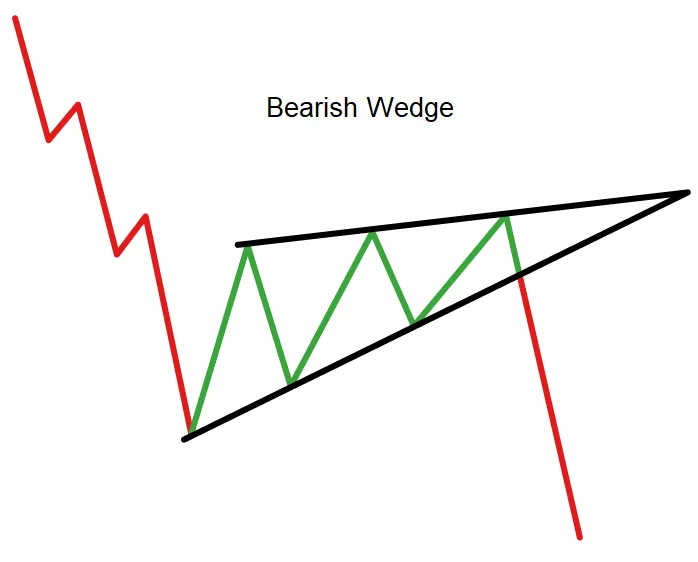
A bearish wedge is the opposite of a bullish wedge. It occurs when there is a consolidation period between two converging trendlines that slant downward. It can signal a potential continuation of the downtrend.
As the price action narrows and approaches the apex of the wedge, traders can expect a breakout either up or down. In most cases, a bearish wedge indicates a future downtrend in asset prices. This is because it generally signifies waning momentum as bearish investors become more cautious.
31. Bullish Cup and Handle
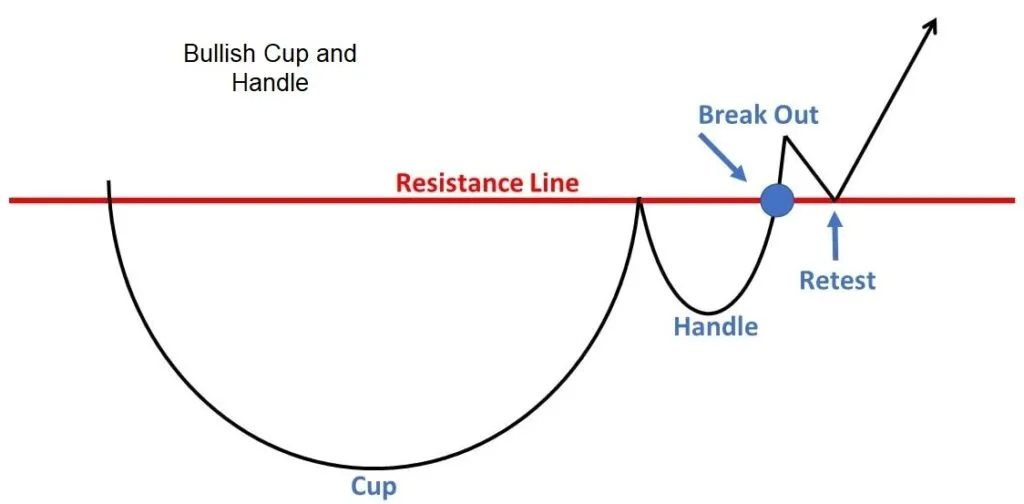
A bullish cup and handle is a continuation pattern that occurs when there is a U-shaped consolidation period followed by a smaller consolidation period that forms a handle. It can signal a potential continuation of the uptrend.
After the price breaks out of the handle and moves higher, it is important to identify the volume to confirm if the breakout is real. If there are high volumes associated with the breakout, then it can be a sign that there will be further upside momentum in the future. In addition to volume, traders should also consider other technical indicators such as RSI, MACD, and Moving Average Convergence Divergence to determine if the breakout is likely to continue.
These tools can provide insight into whether there is strength behind the move or if it will be a short-lived development. Additionally, traders should watch for any reversal patterns that may develop, as these can indicate a potential retracement in price.
32. Bearish Cup and Handle
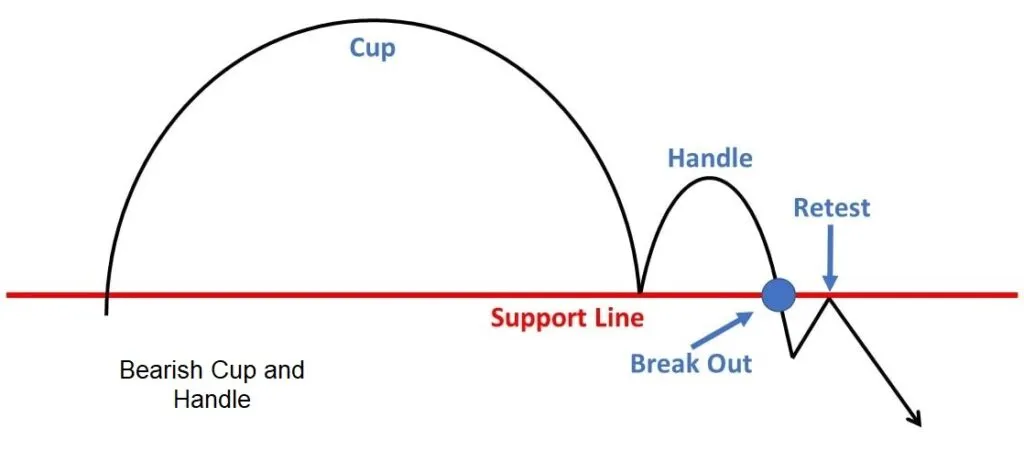
A bearish cup and handle is the opposite of a bullish cup and handle. It occurs when there is an inverted U-shaped consolidation period followed by a smaller consolidation period that forms a handle. It can signal a potential continuation of the downtrend.
As with a bullish cup and handle, traders watch for the price to break out above the resistance formed by the handle in order to confirm a trend reversal. If the breakout fails to move higher, it can signify that the bearish trend may continue. When trading this pattern, it is important to consider other factors such as volume and prices before entering into any trades.
Additionally, traders should set their stop losses at a reasonable level in order to manage their risk. By taking these precautions, traders can ensure that the bearish cup and handle pattern is an effective trading strategy.
The bearish cup and handle pattern can be used to identify short-term trends or potential reversals in the market, making it a versatile trading technique. Traders should pay close attention to the volume of shares traded during the cup and handle formation; if the volume is decreasing as prices form lower highs, this could be an indication that a reversal may soon occur.
33. Bullish Rounding Bottom
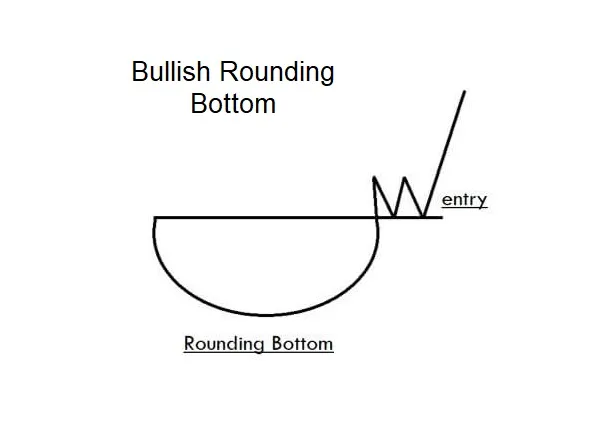
A bullish rounding bottom is a reversal pattern that occurs when there is a long-term downtrend followed by a U-shaped consolidation period. It can signal a potential reversal of the downtrend.
The pattern is formed with two distinct troughs, one lower than the other, followed by a rise that breaks through the previous resistance. This breakout can be used as a buy signal. The length of time for the pattern to form varies depending on market conditions and can last anywhere from several weeks to several months. Investors should look out for volume increases during the consolidation period, as this can be an indication of increased buying activity.
Taking into account other indicators and market conditions can help investors determine whether or not to enter a position. By doing so, they can take advantage of potentially profitable trades in both up and down markets.
Bullish rounding bottoms can also signal a change in trend for down-trending stocks. This pattern typically forms when the price of a security falls to a new low before bouncing back and carving out a U-shape bottom.
This usually signals that sellers have become exhausted and buyers are beginning to step in, pushing the price higher. Investors should also look for an increase in volume during this time, as this can be an indication of increased buying activity.
Investors should also look at the trend itself, rather than just relying on technical indicators. A bullish rounding bottom in a downward-trending stock could be an indication that the downtrend is ending and that prices are beginning to rise again.
If this is the case, investors may want to enter a long position in security. However, if the stock is still in a downtrend after forming the rounding bottom, it may be best to wait for further confirmation before entering any trades.
When analyzing a potential trade based on a rounding bottom pattern, investors should also consider the overall market environment.
If the broader market is trending downwards, then entering a long position based solely on a rounding bottom could be very risky. As with all technical analysis, investors should always take into account fundamental factors as well before entering any trades.
Overall, the rounding bottom pattern can be a helpful tool for traders looking to identify potential buy and sell signals in the stock market. By taking into account both technical and fundamental factors, investors can better identify when a rounding bottom may be forming and use it as part of their trading strategy. With the right knowledge, the rounding bottom pattern can help any trader increase their chances of success in the stock market.
34. Bearish Rounding Top
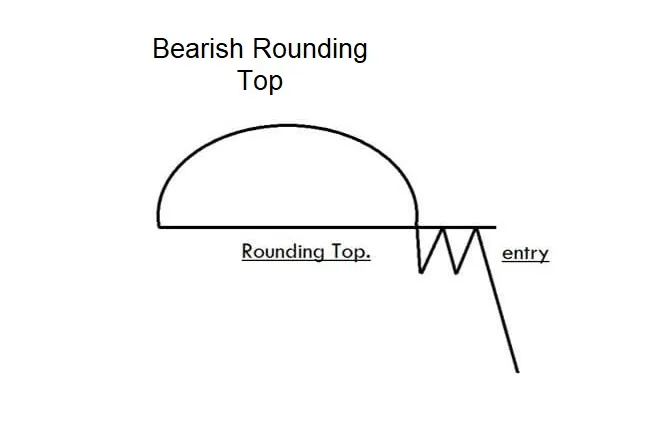
A bearish rounding bottom is a chart pattern that suggests bearish price movement. It is formed when the price trend of an asset shows a series of lower lows followed by a slight rally before returning to lower prices again.
This type of pattern implies that there is strong selling pressure and suggests that the asset’s price may continue to fall in the near future. To identify a bearish rounding bottom, traders must look for a rounded bottom with two distinct troughs and two distinct peaks.
The overall trend should be downwards but the price should display some degree of volatility. Additionally, the volume of trading activity should be increasing during this period. When combined together, these factors can provide valuable insights into an asset’s future price.
As a result, traders must pay close attention to the volume and price movements of an asset in order to properly identify a bearish rounding bottom. If this pattern is identified correctly, it can provide traders with an opportunity to enter short positions or protect existing strategies from potential losses.
However, traders should also be aware that bearish patterns are not always reliable and can be subject to false signals. As such, traders should always practice proper risk management when trading these patterns.
Additionally, it is important for traders to understand the different types of rounding bottoms that exist to properly identify them in the market. By understanding how the bearish pattern occurs, traders can better prepare themselves for potential entry and exit points.
To sum up
Now that we have gone over all 34 candlestick chart patterns in the stock market, it is important to remember that these patterns should be used in conjunction with other technical analysis tools and should not be relied upon solely.
By combining candlestick patterns with other indicators, such as moving averages and volume, traders can increase their chances of making profitable trades.
In conclusion, learning how to read and interpret candlestick chart patterns can be a valuable skill for traders and investors alike. By understanding these patterns and how to use them in combination with other technical analysis tools, traders can improve their ability to identify potential opportunities in the stock market.
FAQs
How reliable are candlestick chart patterns in predicting stock market trends?
Candlestick chart patterns can be a useful tool for predicting potential trends in the stock market. However, they should be used in combination with other technical analysis tools and not relied upon solely.
Can candlestick chart patterns be used in other financial markets besides the stock market?
Yes, candlestick chart patterns can be used in other financial markets, such as forex and commodities trading.
Are all candlestick chart patterns equally important to know?
No, some candlestick chart patterns are more commonly used and considered more important than others. It is important to prioritize learning the most commonly used patterns first.
Is it possible to use candlestick chart patterns in combination with fundamental analysis?
Yes, combining candlestick chart patterns with fundamental analysis can provide a more comprehensive analysis of a stock or asset.
Can candlestick chart patterns be used for long-term investing or are they only useful for short-term trading?
Candlestick chart patterns can be used for both short-term trading and long-term investing. However, they are typically more useful for short-term trading as they focus on short-term price movements. For long-term investing, fundamental analysis may be more important.
